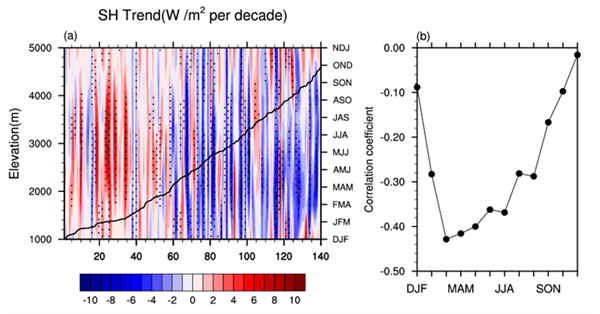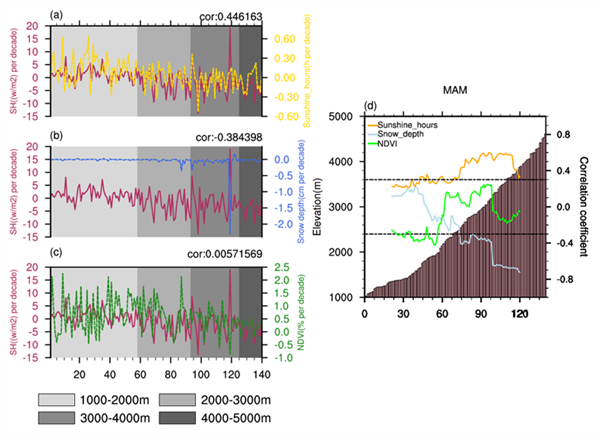The sensible heat (SH) over the Tibetan Plateau (TP) has a notable effect on the onset and intensity of the Asian summer monsoon. In addition, it can also exert an influence on the evolution of global atmospheric circulation and the abnormal of climate. Solar radiation is the direct source of surface sensible heat flux, and the solar irradiance heavily relies on the status of underlying surface——terrain height, for instance. The distinct SH over the TP, compared with that on flat land, should give the credit to high elevation to a large extent. However it is still unclear whether the SH over the TP has an altitude dependence or not.
Focus on this issue, Dr. Zhu Lihua, belonged to Huang Gang team, State Key Laboratory of Numerical Modeling for Atmospheric Sciences and Geophysical Fluid Dynamics, Institute of Atmospheric Physics, Chinese Academy of Sciences, and currently worked as a lecturer in Chengdu University of Information Technology, investigate the elevation-dependent SH trend over the TP and its possible causes. The results reveal that the SH displays a decreasing trend over the TP above 2000m with the magnitude of trend increasing with the elevation. The above feature is more obvious in spring and summer. The SH variation associated with the change in the difference of ground-air temperature (Ts-Ta) may be influenced primarily by the diminution in sunshine duration and snow depth at higher-altitude regions, and the latter is particularly important. The portion of the SH vriation related to the change in surface wind speed is mainly attributed to the dynamic process related to the Pacific Decadal Oscillation (PDO).

Fig. 1a) Elevation-dependent variation of trend for SH of 140 stations during 1980-2015. The black bold curve denotes elevation. Values exceeding the 95% significance level are presented in dots. b) Correlation coefficients between SH trends and elevations of 140 stations.

Fig. 2 Elevation-dependent variation of trend in MAM for SH, a)sunshine duration, b)snow depth and c)NDVI of 140 stations during 1980-2015. Altitudinal range is expressed in gray. d) Correlation coefficients between the SH trend and various factor trend (sunshine duration, snow depth, and NDVI) of every successive 41 stations according to the low-to-high elevation order. Bars represent elevation and correlation coefficient magnitude is plotted on the y axis of right side. Black dashed line indicates the 95% significance level.
The results are published in Climate Dynamics.
Citation: Zhu, L., G. Huang*, G. FAN, X. QU, Z. WANG, and W. HUA, 2018: Elevation-dependent sensible heat flux trend over the Tibetan Plateau and its possible causes, Climate Dynamics, DOI: 10.1007/s00382-018-4360-7. https://link.springer.com/article/10.1007/s00382-018-4360-7